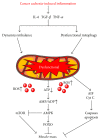Disrupted Skeletal Muscle Mitochondrial Dynamics, Mitophagy, and Biogenesis during Cancer Cachexia: A Role for Inflammation
- PMID: 28785374
- PMCID: PMC5530417
- DOI: 10.1155/2017/3292087
Disrupted Skeletal Muscle Mitochondrial Dynamics, Mitophagy, and Biogenesis during Cancer Cachexia: A Role for Inflammation
Abstract
Chronic inflammation is a hallmark of cancer cachexia in both patients and preclinical models. Cachexia is prevalent in roughly 80% of cancer patients and accounts for up to 20% of all cancer-related deaths. Proinflammatory cytokines IL-6, TNF-α, and TGF-β have been widely examined for their regulation of cancer cachexia. An established characteristic of cachectic skeletal muscle is a disrupted capacity for oxidative metabolism, which is thought to contribute to cancer patient fatigue, diminished metabolic function, and muscle mass loss. This review's primary objective is to highlight emerging evidence linking cancer-induced inflammation to the dysfunctional regulation of mitochondrial dynamics, mitophagy, and biogenesis in cachectic muscle. The potential for either muscle inactivity or exercise to alter mitochondrial dysfunction during cancer cachexia will also be discussed.
Figures



References
Publication types
MeSH terms
LinkOut - more resources
Full Text Sources
Other Literature Sources

